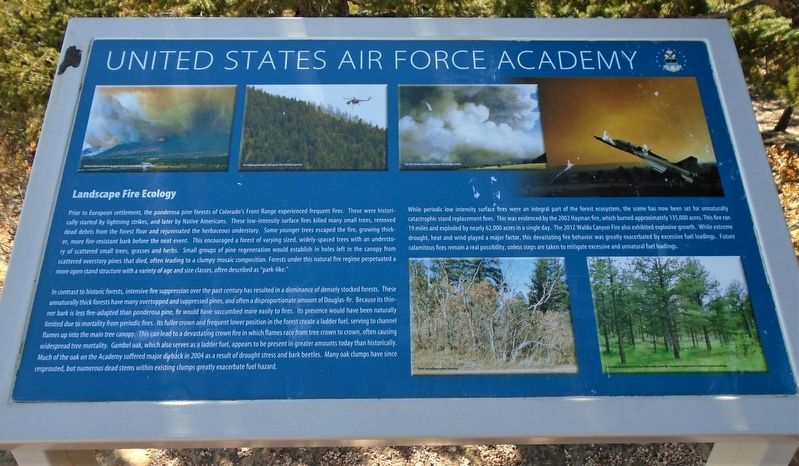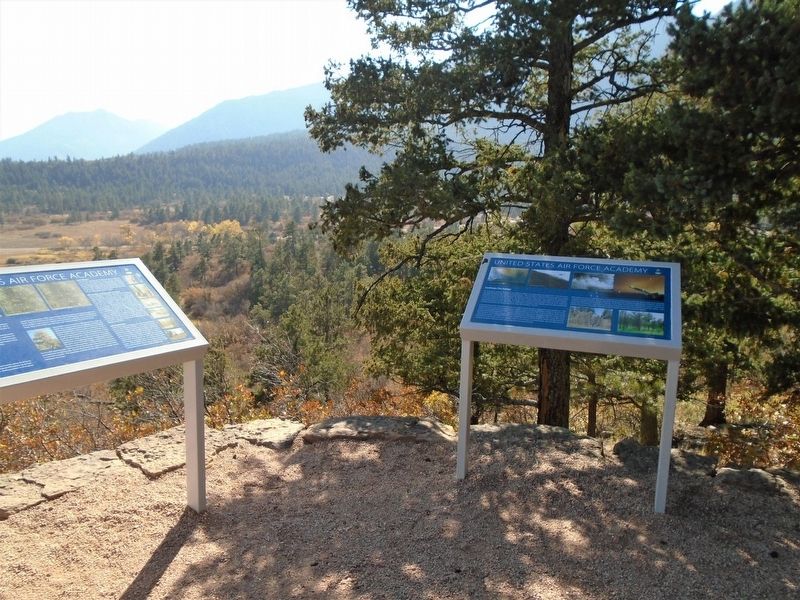Landscape Fire Ecology
United States Air Force Academy
Prior to European settlement, the ponderosa pine forests of Colorado's Front Range experienced frequent fires. These were historically started by lightning strikes, and later by Native Americans. These low-intensity surface fires killed many small trees, removed dead debris from the forest floor and rejuvenated the herbaceous understory. Some younger trees escaped the fire, growing thicker, more fire-resistant bark before the next event. This encouraged a forest of varying sized, widely-spaced trees with an understory of scattered small trees, grasses and herbs. Small groups of pine regeneration would establish in holes left in the canopy from scattered overstory pines that died, often leading to a clumpy mosaic compostion. Forests under this natural fire regime perpetuated a more open stand structure with a variety of age and size classes, often described as "park-like."
In contrast to historic forests, intensive fire suppression over the past century has resulted in a dominance of densely stocked forests. These unnaturally thick forests have many overtopped and suppressed pines, and often a disproportionate amount of Douglas-fir. Because its thinner bark is less fire-adapted than ponderosa pine, fir would have succumbed more easily to fires. Its presence would have been naturally limited due to mortality from periodic fires.
Its fuller crown and frequent lower position in the forest create a ladder fuel, serving to channel flames up into the main tree canopy. This can lead to a devastating crown fire in which flames race from tree crown to tree crown, often causing widespread tree mortality. Gambel oak, which also serves as a ladder fuel, appears to be present in greater amounts today than historically. Much of the oak on the Academy suffered major dieback in 2004 as a result of drought stress and bark beetles. Many oak clumps have since resprouted, but numerous dead stems within existing clumps greatly exacerate fuel hazard.
While periodic low intensity surface fires were an integral part of the forest ecosystem, the scene has now been set for unnaturally catastrophic stand replacement fires. This was evidence by the 2002 Hayman fire, which burned approximately 135,000 acres. This fire ran 19 miles and exploded by nearly 62,000 acres in a single day. The 2012 Waldo Canyon Fire also exhibited explosive growth. While extreme drought, heat and wind played a major factor, this devastating fire behavior was greatly exacerbated by excessive fuel loadings. Future calamitous fires remain a real possibility, unless steps are taken to mitigate excessive and unnatural fuel loadings.
Erected by United States Air Force Academy.
Topics. This historical marker is listed
Location. 39° 0.399′ N, 104° 53.638′ W. Marker is in United States Air Force Academy, Colorado, in El Paso County. Marker is along the walking path from the Visitor Center to the Chapel. Touch for map. Marker is in this post office area: USAF Academy CO 80840, United States of America. Touch for directions.
Other nearby markers. At least 8 other markers are within 3 miles of this marker, measured as the crow flies. Forest Management (here, next to this marker); Veterans Memorial (a few steps from this marker); Scrub (Gambel's) Oak (within shouting distance of this marker); Abert's Squirrel (within shouting distance of this marker); Before the Academy (within shouting distance of this marker); An Ancient Geologic Past (within shouting distance of this marker); Fuel Hazard Mitigation (about 400 feet away, measured in a direct line); Memorial Pavilion Roll Call Record Locator Room (approx. 2.1 miles away). Touch for a list and map of all markers in United States Air Force Academy.
More about this marker. Visitors must have an unexpired official photo ID to present to security to access the USAF Academy grounds.
Also see . . .
1. USAFA Natural Resource Management. (Submitted on October 19, 2020, by William Fischer, Jr. of Scranton, Pennsylvania.)
2. Fire Ecology in Colorado (Colorado State Univ). (Submitted on October 19, 2020, by William Fischer, Jr. of Scranton, Pennsylvania.)
3. Fire Ecology (Colorado Prescribed Fire Council). (Submitted on October 19, 2020, by William Fischer, Jr. of Scranton, Pennsylvania.)
4. Fire Ecology (Rocky Mountain National Park). (Submitted on October 19, 2020, by William Fischer, Jr. of Scranton, Pennsylvania.)
Credits. This page was last revised on October 19, 2020. It was originally submitted on October 19, 2020, by William Fischer, Jr. of Scranton, Pennsylvania. This page has been viewed 97 times since then and 3 times this year. Photos: 1, 2. submitted on October 19, 2020, by William Fischer, Jr. of Scranton, Pennsylvania.

